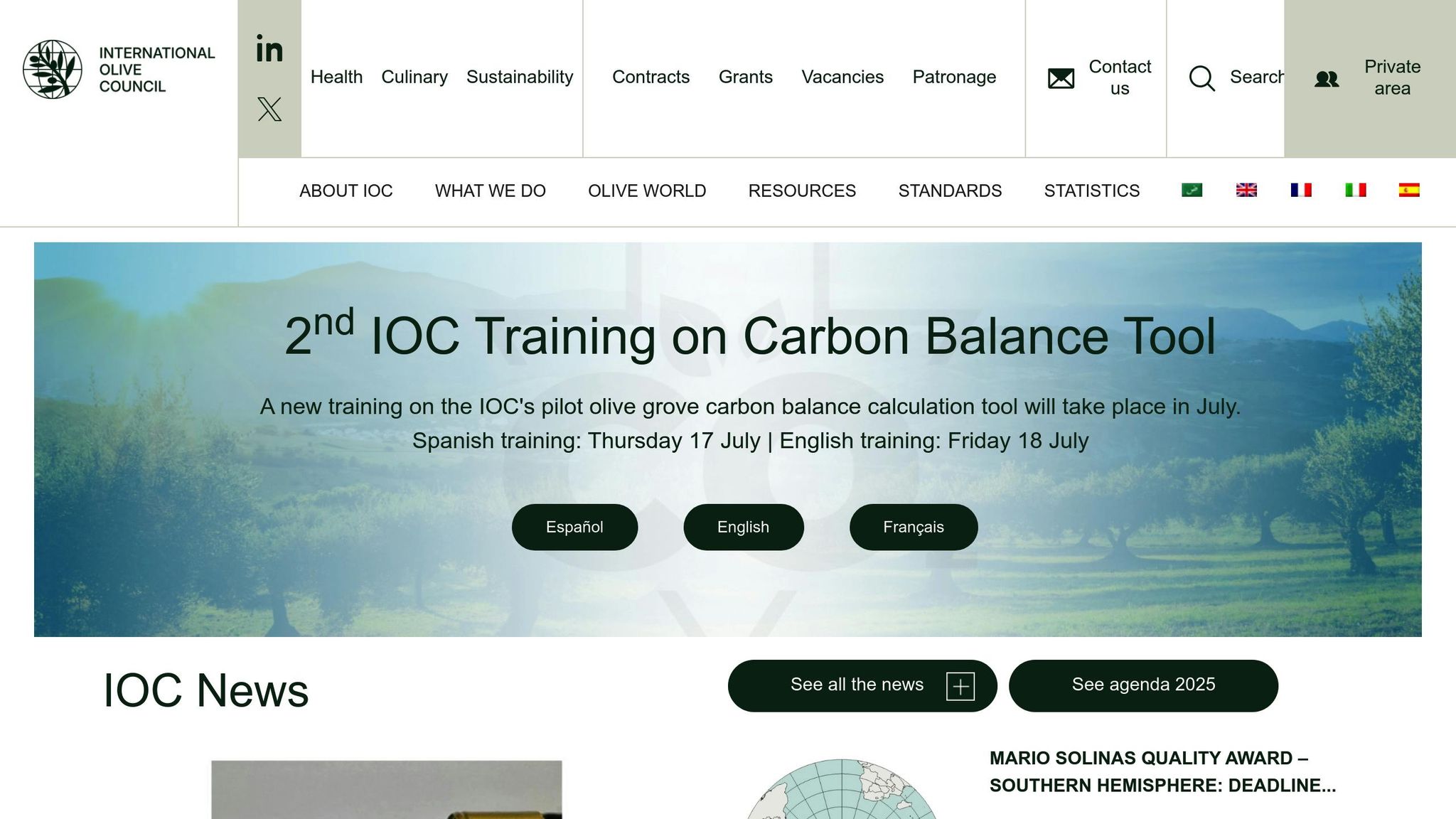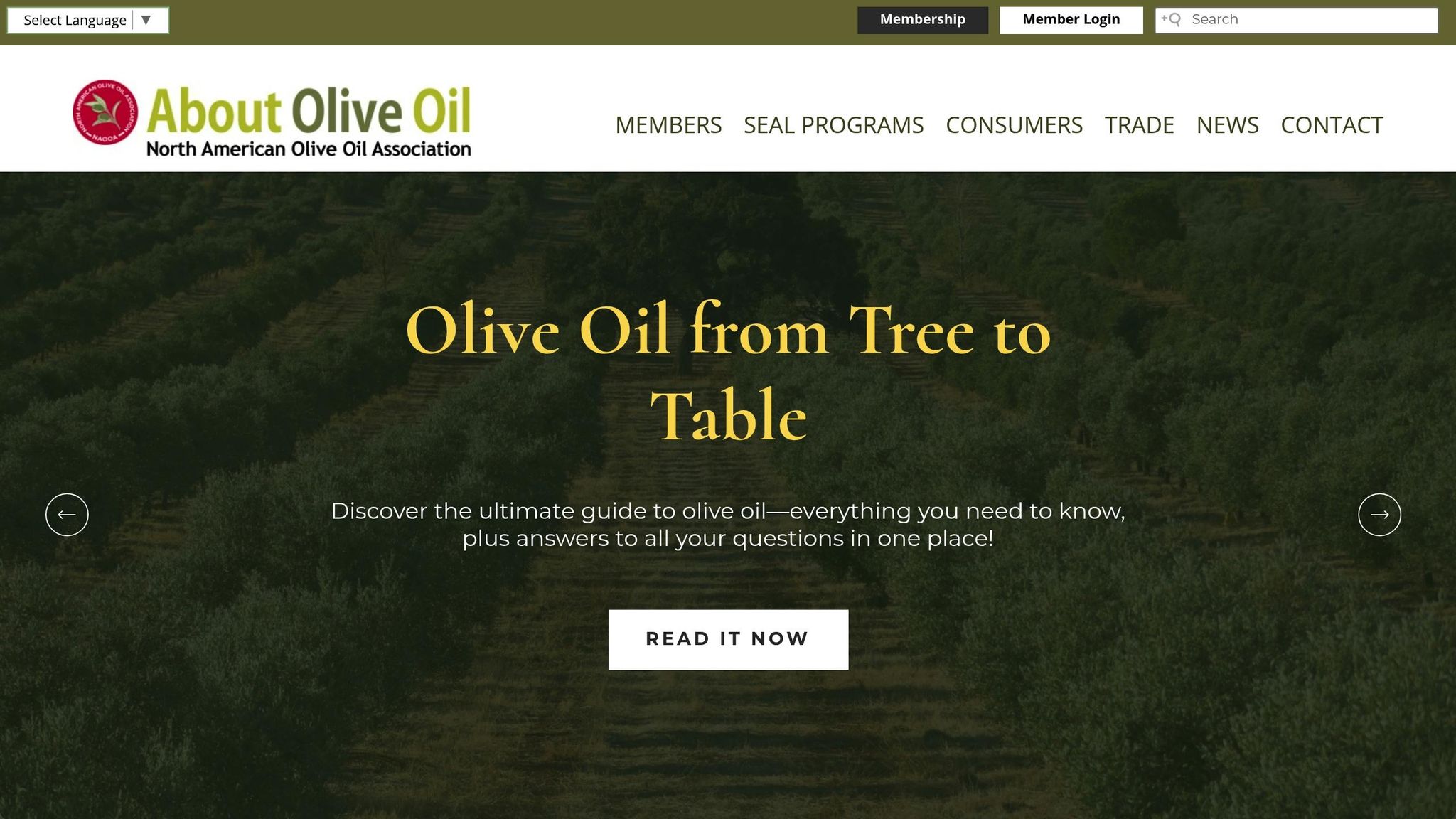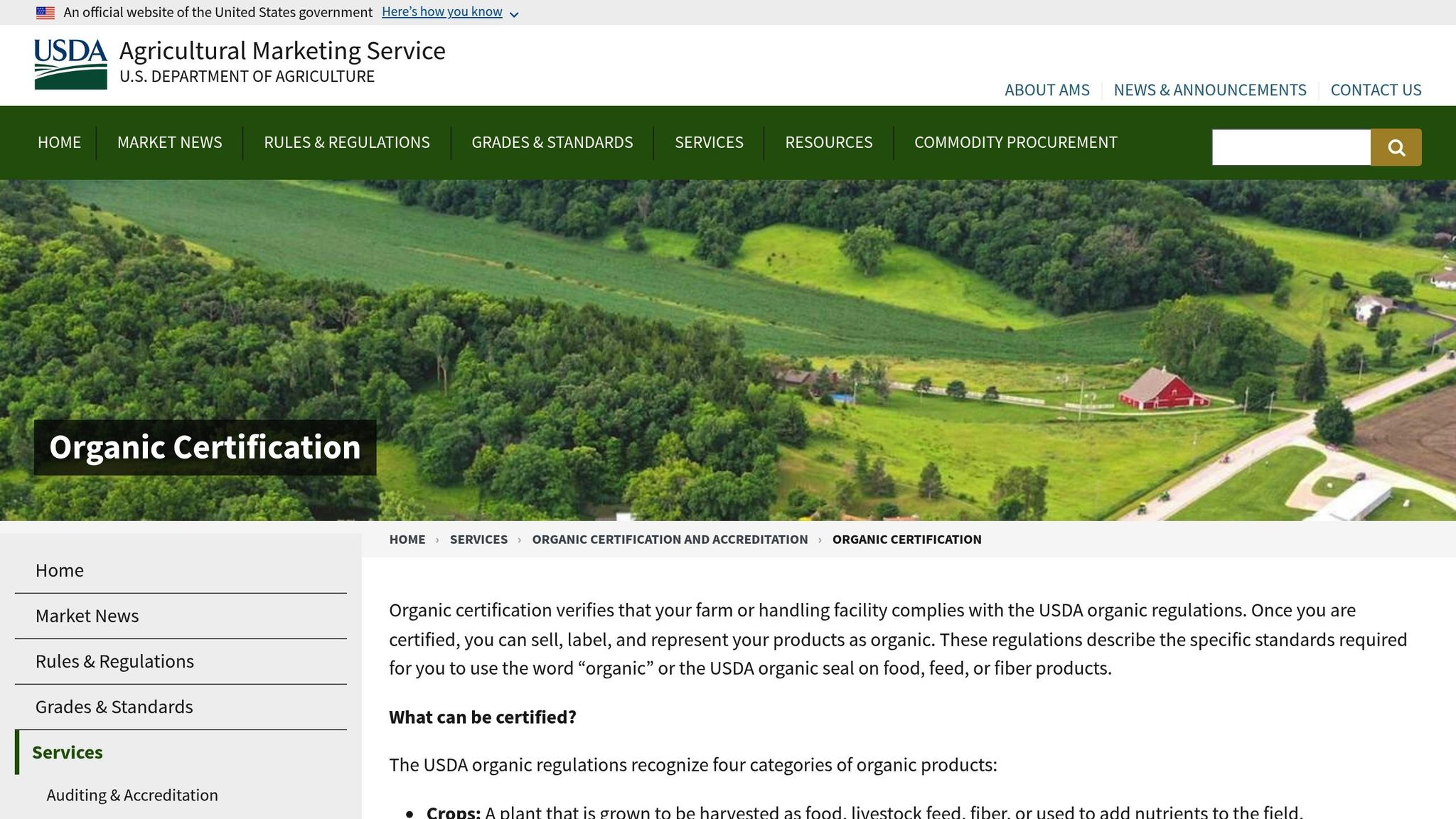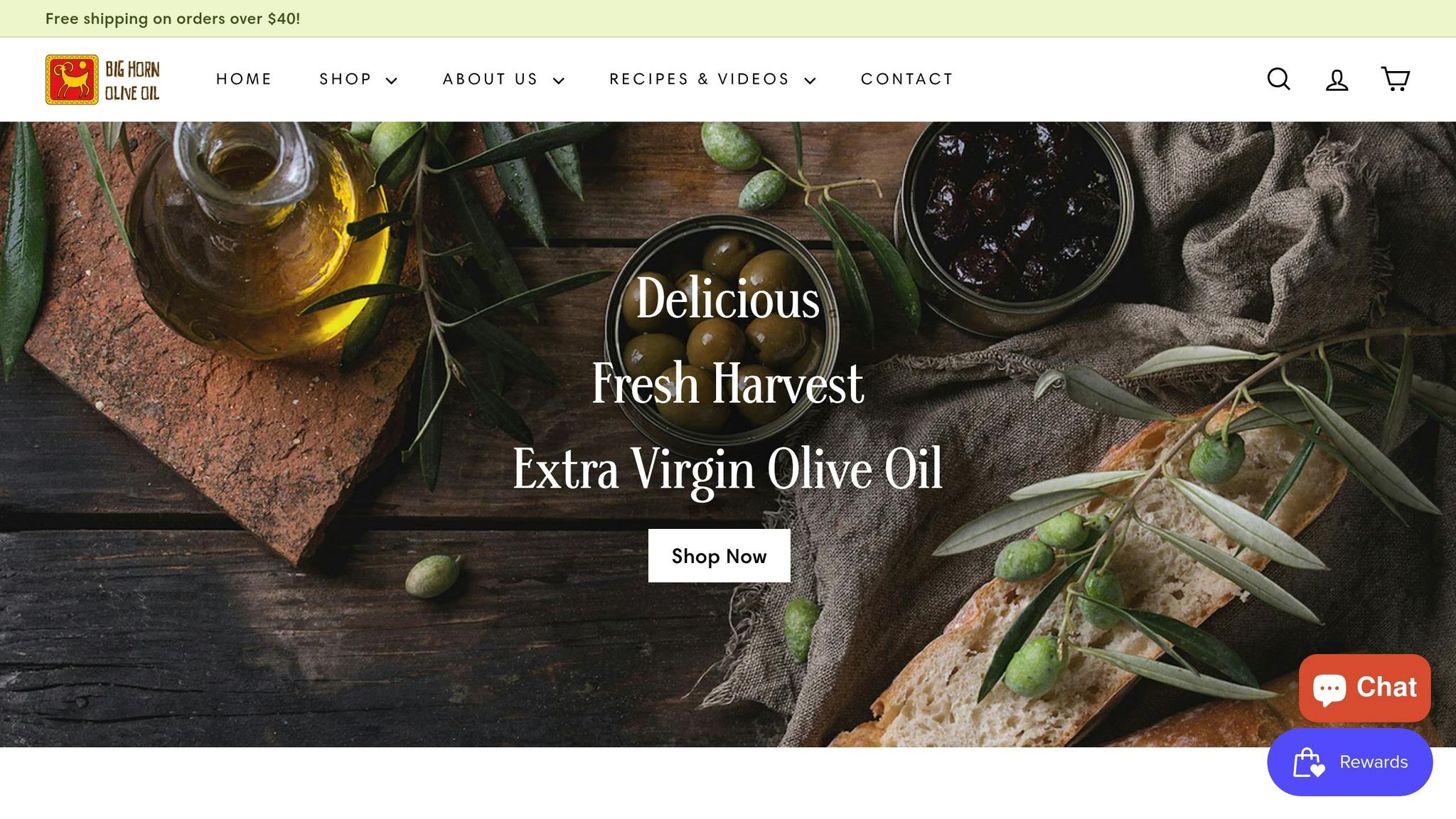Top 5 Olive Oil Certification Standards Worldwide
When shopping for olive oil, certification labels are your best guide to quality and authenticity. These certifications ensure the oil meets strict standards for chemical composition, sensory quality, and traceability. With olive oil fraud being a common issue, understanding these labels helps you make informed choices. Here are the top five olive oil certification standards:
- International Olive Council (IOC): Sets global benchmarks for quality and purity, including chemical and sensory evaluations.
- European Union PDO/PGI: Guarantees geographic origin and production methods specific to regions like Tuscany.
- North American Olive Oil Association (NAOOA): Ensures purity and quality through rigorous testing.
- USDA Organic: Confirms the oil is produced using approved organic farming and handling practices.
- Australian Standard (AS 5264-2011): Focuses on clear labeling, quality benchmarks, and consumer protection.
These certifications rely on advanced testing methods, including chemical analysis, sensory evaluation, and traceability systems, to verify the oil’s quality and origin. Look for seals or labels from these organizations to ensure you’re buying high-quality olive oil.
Olive Oil Standards
How to Read Certification Labels
Certification labels on olive oil bottles are more than just decorative seals - they hold key information about the oil's origin, testing, and adherence to quality standards. Here's how to make sense of them.
What Certification Labels Look Like
These labels often come in the form of official seals, stamps, or badges. They typically include logos, the name of the certifying body, and unique identifiers. For example, you might spot the IOC seal or the USDA Organic logo on a bottle.
What Certification Labels Verify
A legitimate certification label means the oil has passed standardized testing in several crucial areas:
- Chemical Analysis: This includes tests for acidity, peroxide levels, and UV absorption. For extra virgin olive oil, free fatty acids should be below 0.8%, and peroxide values must stay under 20 meq O₂/kg.
- Sensory Testing: Panels evaluate the oil's aroma, flavor, and any defects to ensure it meets sensory quality standards.
- Origin Verification: The label confirms the oil's stated region by tracking the olive varieties and production locations.
Harvest and Lot Codes
Pay attention to harvest dates (e.g., "Harvest: 10/2024") and lot codes (e.g., "LOT: 24-A-1015"). These details help trace the oil's production timeline. Olive oil is at its best when consumed within 18–24 months of the harvest date.
Production Details
Look for information about the milling process. Ideally, olives should be pressed within 24–48 hours of harvest to preserve quality. Terms like "cold extraction" or "extracted below 80°F" indicate gentle processing methods that maintain the oil's nutritional properties.
Quality Metrics to Consider
Certain metrics can offer insights into the oil's quality and health benefits:
- Acidity: Premium oils often have acidity levels below 0.3%.
- Polyphenol Content: These antioxidants, typically ranging from 250 to 500 mg/kg, contribute to the oil's health benefits and flavor complexity.
Regional and Varietal Details
Labels might specify olive varieties, such as Picual or Arbequina, and geographic origins like Tuscany or California. These details highlight the oil's unique flavor profile and terroir. Estate-bottled oils, where production is controlled from grove to bottle, are another sign of high-quality craftsmanship.
These label elements not only verify the oil's quality but also provide a foundation for comparing global certification standards, which will be explored in the sections ahead.
1. International Olive Council Standard

The International Olive Council (IOC) plays a key role in setting global standards for olive oil quality, ensuring transparency and accountability in the industry. These standards are widely adopted as national regulations, providing a framework for consistent quality assurance worldwide.
Quality and Purity Standards
The IOC has established precise chemical benchmarks for different grades of olive oil. For extra virgin olive oil, often considered the highest quality, the free fatty acid content must stay below 0.8%, and peroxide levels cannot exceed 20 meq O₂/kg. Additional parameters include limits for UV absorption (K232 ≤ 2.5, K270 ≤ 0.22), moisture and volatile matter (<0.2%), and insoluble impurities (<0.1%). These specifications ensure proper processing and storage, laying the groundwork for further scientific and sensory evaluations.
Testing Protocols: Chemical and Sensory
To confirm quality, the IOC combines laboratory testing with sensory evaluations. Certified laboratories follow standardized procedures to measure factors like acidity, peroxide levels, and light absorption. These chemical tests provide an objective analysis of the oil's composition.
On the sensory side, trained tasting panels consisting of 8–12 experts evaluate the oil using an official tasting method. Their role is to ensure the oil is free from defects and exhibits a pleasant fruity aroma, a hallmark of high-quality olive oil.
Labeling and Traceability for Consumers
Clear and accurate labeling is another critical aspect of the IOC standards. Labels must prominently display the grade designation (such as Extra Virgin, Virgin, or Olive Oil), helping consumers make informed choices.
To enhance traceability, producers are required to include lot numbers that link the oil to its origin and processing date. This system is particularly valuable for quality investigations or product recalls.
For added assurance, bottles from certified producers may feature the IOC seal, which acts as a quality marker. This seal signifies that the oil has passed rigorous testing, including both scientific analysis and expert sensory evaluation, providing consumers with confidence in the product's authenticity and quality.
2. European Union Protected Designations (PDO and PGI)
The European Union's Protected Designation of Origin (PDO) and Protected Geographical Indication (PGI) certifications set some of the strictest standards for ensuring geographic authenticity in the olive oil industry. These certifications are designed to guarantee that the oil genuinely reflects its regional origins.
Geographic Origin Verification
PDO certification requires that every step of the olive oil's journey - from growing the olives to processing and packaging - takes place within a specific geographic region. For instance, a PDO-certified Tuscan olive oil must use olives grown and processed solely in Tuscany. This ensures an unbroken connection to the region.
PGI certification, while still focused on regional identity, allows for a bit more flexibility. At least one stage of production, processing, or preparation must occur in the designated area. This means that a defining quality, reputation, or characteristic of the oil must be tied to its geographic origin. The PGI approach upholds the link between the product and its region, often preserving traditional methods along the way.
Both certifications go beyond verifying origin - they also enforce strict quality standards. By doing so, they protect the intellectual property rights of products whose characteristics are deeply tied to their region. These protections help prevent imitation and misuse within the EU and in countries with specific agreements, ensuring that the oil meets rigorous quality benchmarks.
Consumer-Facing Labeling and Traceability
Labels play a crucial role in helping consumers identify authentic PDO and PGI olive oils. These labels clearly indicate the region and country of origin, reinforcing the connection between the oil's unique qualities and its geographic source. This transparency allows consumers to trust that they’re purchasing a product with genuine provenance.
3. North American Olive Oil Association Seal

In North America, the olive oil industry upholds its own set of strict standards to ensure quality and authenticity. The North American Olive Oil Association (NAOOA) Seal serves as a trusted marker, guaranteeing that the olive oil has passed stringent physico-chemical tests. This seal provides consumers with confidence in the oil's purity and quality.
4. USDA Organic Certification

The USDA Organic certification ensures that olive oil is produced following strict organic farming and processing practices in the United States. This certification emphasizes how olives are cultivated and handled throughout the entire production process.
Production and Handling Standards
To meet USDA Organic standards, olive growers must rely exclusively on approved natural methods, steering clear of synthetic pesticides, herbicides, and fertilizers. Processing facilities are also required to follow specific guidelines to preserve the organic integrity of the product. While the overall quality of olive oil is assessed separately under USDA specifications, the Organic certification specifically confirms that every stage - from the orchard to the final packaging - adheres to organic production protocols. This certification works alongside chemical and sensory evaluations, ensuring that sustainable practices are part of the process.
Consumer-Facing Labeling and Traceability
The USDA Organic seal is a recognizable marker for consumers. Olive oil labeled with this seal must contain at least 95% organic ingredients, with the remaining 5% limited to a small list of approved non-organic substances. To maintain transparency and compliance, producers are required to keep detailed records and undergo annual inspections.
sbb-itb-4066b8e
5. Australian Standard for Olive Oil and Olive-Pomace Oil
Australia's AS 5264-2011 standard is a cornerstone in maintaining the integrity of olive oil products. Designed with a strong focus on consumer protection, it ensures transparency in labeling and safeguards the supply chain, offering clear and reliable product information.
Quality and Purity Standards
The Australian standard sets rigorous quality benchmarks to prevent deceptive practices in the marketplace. For instance, Lampante Virgin Olive Oil and Crude Olive Pomace Oil are strictly prohibited from being sold directly to consumers. Additionally, the standard eliminates ambiguity in labeling by forbidding olive pomace oil from being marketed simply as "olive oil".
To further protect consumers, the use of misleading terms like "pure", "light", "extra lite", or "lite" is explicitly banned from olive oil labels. This measure aims to reduce confusion and ensure clarity for buyers.
Consumer-Facing Labeling and Traceability
AS 5264-2011 mandates comprehensive and transparent labeling. Each label must include key details such as:
- Country of origin
- Net contents
- Ingredients
- Nutritional information
- Storage instructions
- Best before date
- Company contact details
These requirements align with Food Standards Australia New Zealand regulations and Australian Consumer Law, ensuring uniformity and clarity in product presentation.
The standard also enforces a scientifically determined "best before" date. This date is calculated using results from three critical tests - Rancimat® (induction time), Pyropheophytin a (PPP), and 1,2 Diacylglycerides (DAGs) - and cannot exceed two years from the packaging date. Producers must provide technical evidence to substantiate these dates.
Testing Protocols (Chemical and Sensory)
Producers in Australia are required to conduct regular testing to maintain product quality and adjust best before dates as needed. Recommended tests include PPPs, DAGs, and induction time measurements. Alternatively, producers can opt for specialized shelf-life calculation tests to ensure accuracy.
For added consumer confidence, members of the Australian Olive Association can apply for the OliveCare® Australian Extra Virgin Certified Logo. This certification signals adherence to high-quality standards and assures authenticity, helping consumers trust the origin and quality of Australian olive products.
Geographic Origin Verification
In line with international standards, AS 5264-2011 emphasizes verifying the oil's geographic origin. This includes confirming the country or region of production and substantiating any claims like "cold pressed" or "first extraction".
To promote even greater transparency, producers are encouraged to provide additional details such as the harvest date, product description, olive cultivar information, awards, and organic certifications. These enhancements empower consumers to make well-informed purchasing decisions based on detailed and accurate product information.
Standards Comparison Chart
Understanding how different certifications influence your olive oil choice can make a big difference. Each certification comes with its own focus, criteria, and benefits, so knowing what they stand for helps you make informed decisions about the olive oil you bring home.
Here’s a closer look at two globally recognized olive oil certification standards. This chart breaks down their scope, requirements, label indications in the US, and their strengths and limitations, giving you a clearer picture of how these standards work and what they mean for consumers.
| Standard | Certification Scope | Core Requirements | Label Cues Seen in the US | Strengths for Consumers | Limitations |
|---|---|---|---|---|---|
| International Olive Council (IOC) Standard | Focuses on setting international trade standards, chemical testing methods, and sensory evaluation protocols for olive oils and olive-pomace oils. Aims to ensure quality, purity, and authenticity, including fraud prevention. | Requires adherence to strict chemical and sensory benchmarks, like fatty acid composition, peroxide value, and phenolic content. Includes sensory analysis through panel tests for virgin olive oils. Regularly updates testing methods based on new scientific developments. | While not directly visible on US labels, many American certifications rely on IOC standards as their foundation. | Offers a globally recognized quality benchmark, ensuring olive oils meet rigorous chemical and sensory requirements. | Primarily designed for trade and technical analysis. It doesn’t provide a consumer-facing seal or regulate marketing practices in specific countries. Compliance is often voluntary or adopted by local regulations. |
| European Union Protected Designations (PDO and PGI) | Regulates origin and production methods within the EU, aligning with IOC standards. Covers marketing rules, official controls, traceability, and packaging facility approvals. | Includes updates like Regulation EU 2022/2104 for olive oil marketing standards and Regulation EU 2022/2105 for conformity checks. These checks involve a minimum frequency (one per 1,000 tons marketed annually), risk-based selective checks, record-keeping, and sensory verification by approved tasting panels. | Labels such as "Protected Designation of Origin (PDO)" and "Protected Geographical Indication (PGI)" indicate compliance with strict origin and production method standards. | Guarantees high-quality olive oil with verified geographical origin and traditional production methods. Backed by mandatory controls and traceability measures. | Focused on the European Union. While it aligns with IOC standards, its rules and enforcement are specific to the EU market. |
When you compare these standards, some key differences stand out. The IOC Standard is all about technical precision, focusing on chemical and sensory evaluations. On the other hand, the EU’s PDO and PGI certifications highlight geographical authenticity and traditional production methods, ensuring traceability and adherence to strict origin rules.
These rigorous standards help producers, like Big Horn Olive Oil, maintain the trust of American consumers. For instance, EU regulations mandate at least one conformity check per 1,000 tons marketed annually, ensuring consistent quality and authenticity.
Testing and Verification Methods
When it comes to ensuring the quality of olive oil, three key methods are at the heart of certification: chemical analysis, sensory evaluation, and traceability verification. Together, these approaches confirm that the olive oil you buy lives up to the claims on its label.
Chemical analysis is the first step in verifying quality. For extra virgin olive oil, the free fatty acid content must stay below 0.8% (measured as oleic acid). Another critical measurement is the peroxide value, which must be below 20 milliequivalents O₂/kg to confirm freshness. Oils with higher peroxide values have begun to oxidize, even if the rancidity isn’t yet noticeable. Oxidized oil not only loses its health benefits but also develops unpleasant flavors over time.
Another important measure is phenolic content, which reflects the oil's antioxidant levels. These antioxidants help extend shelf life and provide health benefits. Many certification programs set minimum phenolic content requirements, typically measured in milligrams per kilogram of oil.
Next comes sensory evaluation, where trained tasting panels assess the oil's characteristics. These panels, usually made up of 8-12 experts, evaluate positive traits like fruitiness, bitterness, and pungency while detecting flaws such as rancidity, mustiness, or metallic notes. The International Olive Council has developed strict protocols for these sensory tests, which many certification bodies follow.
After passing chemical and sensory tests, traceability systems ensure the oil’s authenticity from grove to bottle. Certification programs require detailed records that document every step: where the olives were grown, when they were harvested, how they were processed, and where the oil was bottled. This creates a transparent paper trail that auditors can verify.
Technology plays a growing role in traceability. For instance, many certification programs now use blockchain technology and QR codes to provide consumers with detailed product information. By scanning a QR code on a certified olive oil bottle, you might discover the farm where the olives were grown, the harvest date, and even the results of chemical tests for that particular batch.
Verification doesn’t stop there. Certification bodies often conduct unannounced facility inspections, perform random retail sampling, and rely on third-party laboratory testing. For example, the North American Olive Oil Association performs routine testing of member products and shares the results to ensure transparency.
Producers also use batch testing to maintain consistent quality. Instead of relying solely on samples sent for certification, many test every batch or lot of oil they produce. This ongoing quality control ensures the standards consumers expect are met with every bottle.
Lastly, certification seals on olive oil bottles in the US indicate third-party verification. These seals confirm that the oil has passed both chemical and sensory testing by independent labs, not just the producer’s own quality checks.
For example, Big Horn Olive Oil adheres to international quality standards by conducting rigorous chemical and sensory evaluations, giving customers confidence in the product’s verified quality.
How Big Horn Olive Oil Meets Quality Standards

Big Horn Olive Oil stands out by adhering to strict global certification standards, ensuring exceptional quality at every step of production. The company’s dedication to Ultra Premium Extra Virgin standards sets it apart, as achieving this status requires meeting more demanding chemical and sensory criteria than other certifications.
A key factor in their process is the rapid cold-pressing of olives within just two hours of harvest. This approach minimizes oxidation, a common issue when processing is delayed, and helps retain the oil’s natural compounds. Industry organizations like the International Olive Council and the North American Olive Oil Association emphasize the importance of immediate processing, and Big Horn Olive Oil’s methods align with these best practices.
Freshness is another cornerstone of their quality. By delivering oils from fresh harvests within three months, they ensure superior traceability and preserve the oil’s natural antioxidants and beneficial properties. In contrast to oils that might sit on shelves for extended periods, Big Horn Olive Oil prioritizes prompt delivery to maintain peak flavor and quality.
The company’s sourcing also reflects its commitment to excellence. By selecting olives from Modena, Italy - a region celebrated for its culinary heritage and Protected Designation of Origin products - Big Horn Olive Oil connects its products to a tradition of authenticity and craftsmanship.
High antioxidant levels not only enhance the health benefits of their oils but also contribute to the vibrant, fruity flavor that appeals to discerning palates. Whether in their traditional single-cultivar oils or their infused varieties, the quality of the base oil allows every flavor to shine, from classic profiles to creative infusions.
Conclusion
Knowing olive oil certification standards can help you make smarter choices when picking products for your kitchen. These five global standards act as safeguards, protecting consumers from lower-quality or fraudulent oils.
Each certification focuses on a specific aspect of olive oil quality. Whether it's detailed chemical testing, organic production requirements, or verifying geographic origins, these standards ensure that the oil you’re buying meets strict criteria.
When browsing for olive oil, look for certification logos on the label. These logos aren’t just decorative - they confirm that the product has been independently verified for quality, authenticity, and traceability. If a bottle carries multiple certifications, it often signals that the producer has gone above and beyond the basic requirements.
The rigorous testing behind these certifications adds scientific credibility to quality claims. Certified oils undergo thorough examination, far exceeding standard food safety checks.
As the olive oil market evolves, so do these certifications. They’re adapting to tackle challenges like climate change and shifting consumer preferences. By choosing certified olive oils, you’re not only prioritizing quality for your meals but also supporting producers who uphold these high standards.
Lastly, don’t overlook the importance of freshness. Even the best-certified olive oil will lose its benefits over time. Quick processing and delivery, like Big Horn Olive Oil emphasizes, ensure you enjoy the oil at its peak quality. Freshness and certification go hand in hand when it comes to selecting the best olive oil for your table.
FAQs
How can I tell if an olive oil meets one of the top global certification standards?
When determining if an olive oil meets high-quality standards, start by looking for official certification seals on the label. Certifications like PDO (Protected Designation of Origin), PGI (Protected Geographical Indication), or certified organic marks show that the oil adheres to strict quality and origin requirements.
Pay attention to details such as the harvest date, the origin of the olives, and any certification numbers listed. For extra peace of mind, you can cross-check the product's authenticity by visiting the certifying organization’s website or database. Many reputable producers also share lab analysis reports or sensory evaluation results, offering additional transparency and proof of their certification.
What is the difference between the International Olive Council standards and the EU's PDO/PGI certifications?
The International Olive Council (IOC) standards and the EU's PDO (Protected Designation of Origin) and PGI (Protected Geographical Indication) certifications serve distinct purposes within the olive oil industry.
The IOC standards establish global quality guidelines for olive oil. These include chemical and sensory tests designed to confirm the oil's authenticity, maintain high quality, and ensure consumer safety across international markets. By setting these benchmarks, the IOC works to combat fraud and uphold trust in olive oil production worldwide.
Meanwhile, PDO and PGI certifications focus on geographical identity and traditional production practices. PDO certification requires that most of the raw materials and production processes occur within a specific region, ensuring a strong connection to that area's heritage. PGI, while still emphasizing regional characteristics, is more flexible, allowing for a broader range of sourcing within a defined area. These certifications protect local products from imitation and highlight the distinctive qualities tied to their places of origin.
In essence, while the IOC standards center on quality and safety, PDO and PGI are all about heritage and authenticity.
Why should you check the harvest date and production details when buying olive oil?
Why You Should Check the Harvest Date and Production Details
When it comes to olive oil, freshness is everything. The harvest date is a key indicator of how fresh the oil is, and freshness directly affects both its taste and nutritional benefits. Ideally, olive oil should be consumed within a year or two of harvest to fully enjoy its flavor and health perks. Oils from early-harvest olives tend to have a bolder taste and are packed with antioxidants, while later harvests produce gentler flavors with their own unique profiles.
Production details are equally important. They give you insight into the oil’s authenticity and quality. Knowing when and how the olives were pressed helps ensure you’re buying an oil that retains its beneficial properties and meets high standards. To make the most of your purchase, always look for olive oil that clearly states its origin and production process.

